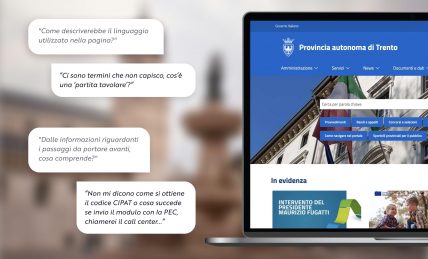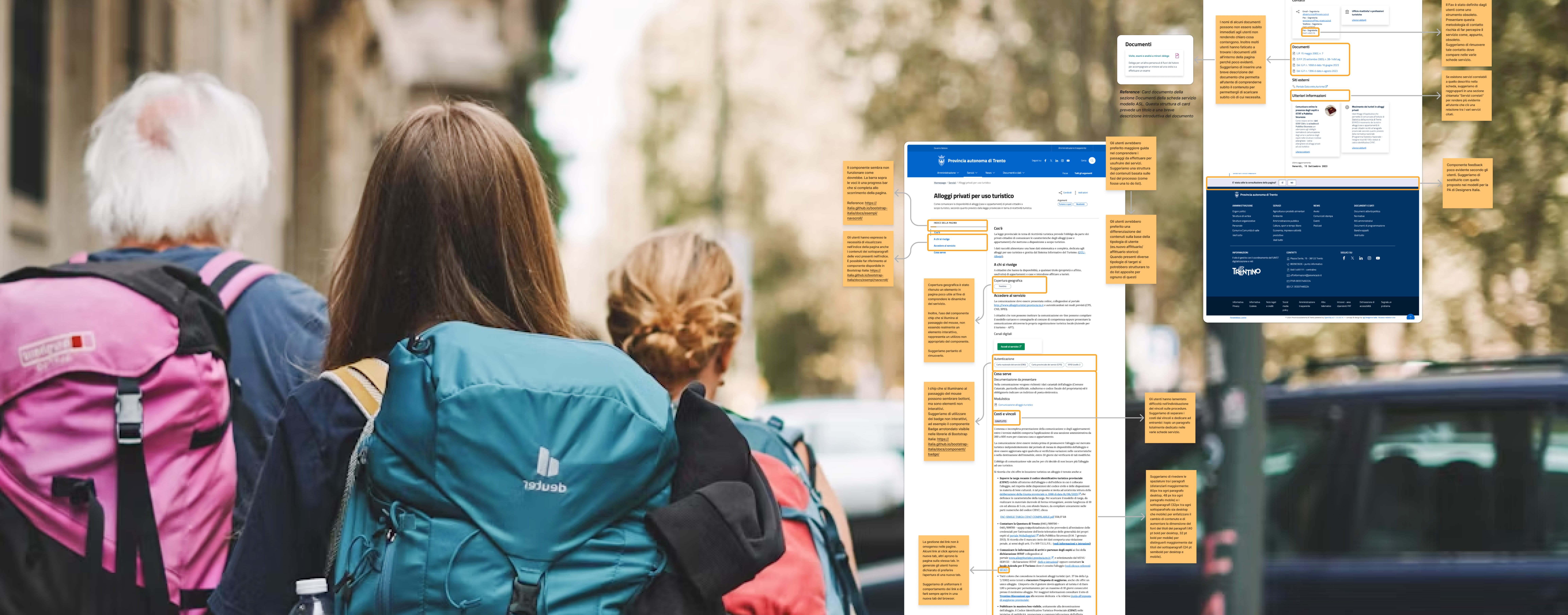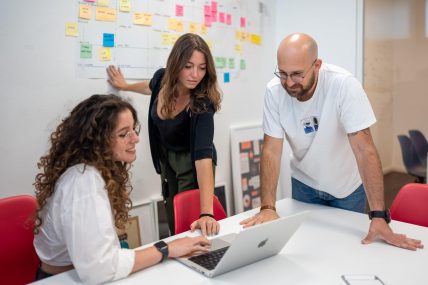Autonomous Province of Trento
Analysis and user research on the Catalogue of Services of the Autonomous Province of Trento (PAT) to improve the digital experience of citizens

The Autonomous Province of Trento, as part of its public administration digitisation project, has decided to improve access to its digital services through the online Service Catalogue. The aim was to offer a more intuitive and inclusive user experience, responding to the growing needs of a population increasingly accustomed to using digital tools to interact with institutions.
This initiative stems from the need to make the portal more efficient and accessible, reducing the difficulties users face when searching for information and using services. To achieve these goals, we were commissioned to conduct a series of tests with users, aimed at identifying critical issues and proposing concrete solutions for improvement.
The chosen approach was user research and user testing, which also included accessibility tests with visually impaired and blind users. The methodological approach focused on identifying and solving usability issues, ensuring that each intervention was based on concrete data and insights from real users.
This initiative was part of the PNC-A.1.3 Flagship project, funded by the Complementary National Plan, which aims to support digitisation and innovation in the public sector.
Activities
We organised and carried out a user-testing campaign, divided into several strategic phases. The work was structured to answer the research questions and achieve the project objectives.
The main activities performed were:
- Definition of test scenarios: starting with the most frequently used services in the province, the flows to be tested were identified, with the participation of the Motor Vehicle, Land Registry and Sport and Tourism offices.
- Definition of the research protocol: elaboration of the aims, methods and requirements of the tests, ensuring that each session covered the main critical issues that emerged in the preliminary analysis phase.
- Recruitment of tester users: in cooperation with HIT - Hub Innovazione Trentino, we selected a representative sample of 48 users. Through the Italian Union of the Blind and Partially Sighted (UICI) of Trento, we also recruited six visually impaired and blind users to test the accessibility of the portal.
- Conducting the tests: the 54 tests were conducted at the offices of the Province and the headquarters of the Italian Union of the Blind and Partially Sighted (UICI) of Trento, simulating real-life scenarios of use, such as obtaining a driving licence, its renewal and conversion from non-European states, the qualification for tourist use of private accommodation, consulting the land register and applying for funding for sports association initiatives.
- Data analysis and presentation to stakeholders: the collected data were analysed to identify recurring patterns and priorities for action. The results were shared with stakeholders through a detailed report and a dedicated workshop to define the next steps.
Results
The tests revealed fundamental insights to improve the Service Catalogue of the Autonomous Province of Trento, with direct benefits for citizens. The main results included:
- Clarity of information: there were significant difficulties in understanding online instructions and procedures. The recommendations provided included:
- The rewriting of complex texts in simpler and more direct language.
- In-depth coverage of topics frequently requested by users, such as how to renew a driving licence and how to qualify for tourist accommodation.
- The addition of visual support materials, such as guides and infographics, to facilitate understanding.
The terms used on this Land Registry page are a bit technical, maybe you need to be in the industry to understand everything properly.
- Improved accessibility: Accessibility tests identified specific criticalities, such as the absence of adequate contrasts or navigation paths that were not intuitive for screen readers. The proposed solutions included:
- Improvement of visual contrasts to enhance readability.
- Optimisation of page structure to ensure an inclusive experience, including for visually impaired and blind users.
- Simplification of online forms to reduce filling-in time and increase efficiency.
Some sections are not clear to me, but rather than call I would send an email so that I have a written record, like a note...
Guidelines for redesigning the catalogue of services: PAT has undertaken a redesign of the entire Institutional Portal of the Province, and for the Catalogue section, it will implement the improvements suggested as a result of the tests.
Value generated for the client and the citizens
The final report provided practical guidelines that the provincial departments implemented at low cost, significantly improving the user experience. The main benefits included:
- Reduced support requests thanks to clearer information and simplified procedures.
- Increased user satisfaction, as users find the portal more intuitive and accessible.
- A more inclusive point of reference, with a greater focus on the needs of all citizens

Process and methodology
Phase 1: Definition of test scenarios
The first phase of the project was dedicated to the definition of test scenarios. In order to identify the flows to be tested, we analysed the navigation data of the Service Catalogue and collected user feedback, both through direct feedback and through questionnaires addressed to the call centres of the most used services.
Working together with the departments of Motor Vehicles, Land Registry and Sport and Tourism, the main challenges were identified, such as finding specific information, understanding complex bureaucratic procedures and filling out online forms. These tasks were included in the test scenarios to represent the most frequent and critical user actions.
Phase 2: Defining the research protocol
To ensure the consistency and effectiveness of the testing sessions, we developed a detailed protocol that guided the entire process. This document defined:
- The main objectives of the test sessions.
- The methods and tools used to collect the data.
- The specific requirements of participants.
- The schedule of activities.
The drafting of the protocol was accompanied by meetings with the Province's stakeholders to ensure that the project objectives were aligned with the needs of the end users and that the tests were aimed at solving real problems.
Phase 3: Recruitment of tester users
The recruitment process was a crucial step in ensuring the sample of users involved in the tests was representative. In collaboration with HIT - Hub Innovazione Trentino, we selected 48 users representing different age groups, levels of digital competence and socio-economic backgrounds, with specific requirements depending on the flow being tested (e.g. individuals who had recently obtained a driving licence for the flow on obtaining a driving licence, or accommodation owners for the pages on private tourist accommodation).
In parallel, through the UICI of Trento, six visually impaired and blind users were recruited. This made it possible to include accessibility requirements in the tests, ensuring that the portal could also be used by visually impaired people.
Phase 4: Conducting tests
The 54 test sessions, which took place over the course of a week, were conducted at the Province offices for the usability tests and at the UICI Trento headquarters for the accessibility tests.
During the sessions, users performed specific tasks that simulated real-life scenarios of portal use. Activities included searching for information, navigating between different sections of the portal and filling in online forms.
To facilitate the identification of key insights and practical solutions, we organised the sessions in such a way as to perform a preliminary tagging activity, assigning a specific topic to each transcript immediately after each session. This approach allowed us to identify emerging patterns during the conduct of the tests, quickly directing the work towards concrete answers to critical issues.
For each service tested, the feedback gathered highlighted the main difficulties encountered by users, such as searching for specific information, the lack of clarity of the instructions provided and accessibility issues for visually impaired users.
Phase 5: Data analysis and presentation to stakeholders
Once the tests were completed, analysis of the collected data enabled the identification of key insights and the formulation of practical recommendations to optimise the portal.
The main results were presented during a presentation to provincial officials and administrative managers, where priorities for action were discussed and the next steps to implement improvements were defined.
Challenges and solutions
The main challenges faced during the project can be summarised in these three points:
- Defining the scope of action: in order to narrow the focus to the most critical flows among the numerous services initially considered, the analysis of navigation data and user feedback was crucial. This approach made it possible to identify and prioritise the most important services, such as those related to motor vehicles and tourism.
- Logistical organisation of the tests: conducting more than 50 tests in a single week required detailed planning and strict quality control. To ensure the effectiveness of the tests, the team made preliminary calls to verify that the selected testers met the specific requirements and that each session was valid and representative.
- Summarising a large amount of data: the numerous interviews produced various insights, so it was crucial to identify key points to share with stakeholders and recommend interventions to be prioritised. In this sense, incorporating some quantitative data collection made it possible to communicate the extent of certain phenomena in a more effective and immediate way, and then to detail them with qualitative insights.

Working with Tangible has provided us with a structured and high-quality way of tackling the challenges of digitising public services. The approach, with clear communication and constant visibility of progress, ensured effective alignment throughout the project.
This not only led to concrete results in improving the usability and accessibility of our portal but also facilitated a valuable skills transfer for our team, allowing us to gain a greater awareness of user experience methodologies and processes. An experience that exceeded our expectations and opened up new perspectives on how to integrate UX into future projects.



